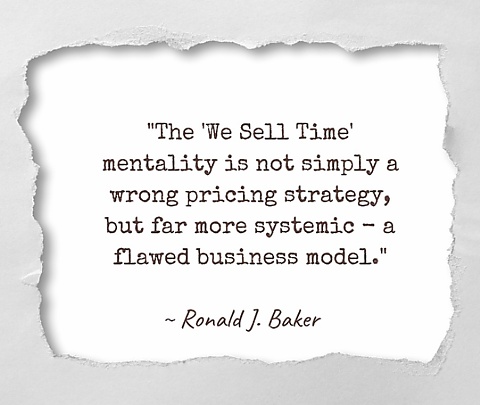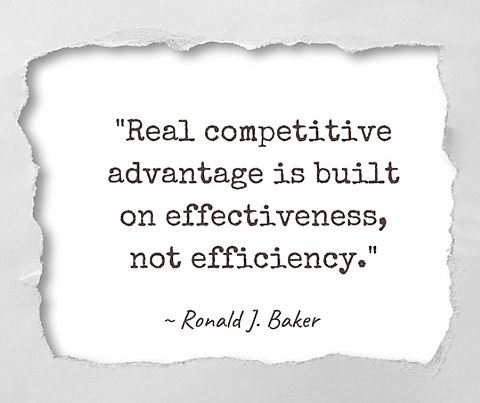Why ‘Implementing Value Pricing’ by Ronald J. Baker is an essential read for all professionals currently billing by the hour.
“Implementing Value Pricing” by Ronald J. Baker is a book that changed the course of my practice forever and I have never looked back.
Ronald J. Baker is a game-changer in the accounting world. He’s not just an author; he’s a thought leader who founded VeraSage Institute to shake up traditional billing practices.
Known for this and other groundbreaking books, Ron Baker has traveled the globe, teaching professionals how to make more money by focusing on value, not hours.
He’s the go-to guru for turning business models on their head.
Back in 2014, along with another partner from my firm, I was lucky enough to have been part of the second wave of the Black Swan Project through the CPB (then IPBC in Canada).
Our mentor was none other than Ron Baker himself. It was a truly life changing experience that elevated our company’s culture and our customers’ experience.
The changes in our firm did not happen overnight and it was not easy. Most hurdles were based in our own fear of going against the grain of established norms of the profession, foremost of which is the billable hour.
But having the guru of value pricing himself guide us through the process kept us on the path to complete the change.
Yes, there were hiccups. Yes, there was internal resistance from time to time. But in the end, now years later, we are glad that we took the plunge.It is the best thing we could have done for our firm, ourselves and our customers.
So, if like me, you’re a small business owner, accountant, lawyer, or any professional whose business model is anchored on the billable hour, then Ronald J. Baker’s “Implementing Value Pricing: A Radical Business Model for Professional Firms” is a must-read.
In this article, I intend to both review this seminal book and illustrate its application through a hypothetical business scenario.
Book Review: “Implementing Value Pricing” by Ronald J. Baker
“Implementing Value Pricing” by Ronald J. Baker is a game-changing playbook for professionals stuck in the billable-hour rut.
This transformative read shakes the foundations of traditional billing, empowering you to swap time-based fees for a value-driven approach.
The primary focus of the book is to challenge and reframe the conventional billing practices in professional service firms.
Baker contends that the billable hour model is inherently flawed and advocates for a value-based pricing strategy, which aligns more closely with the true value professionals offer to their customers.
This book shows you how to elevate your profits and customer satisfaction by aligning your pricing with the actual value you deliver. It’s not just a book; it’s a revolution for your business model!

A. Overview of the Book
According to Jay Shepherd who wrote the foreword for “Implementing Value Pricing”: “Reading this book may cause a Ron Baker Headache.”
When I first heard Ron Baker speak about Value Pricing at an IPBC Conference in Canada, he warned us of this headache.
And he was right. The book takes everything you have learned about pricing and turns it upside down. You get the Ron Baker headache from it but it is a very good headache to have. One that shifts your thinking and propels you into action.
The book wakes you up.
So let’s delve in.
Main Theme and Purpose
The central theme and purpose of “Implementing Value Pricing: A Radical Business Model for Professional Firms” is nothing short of a paradigm shift for professionals anchored in the billable-hour model.
Ronald J. Baker argues passionately and convincingly that this traditional model is not only outdated but inherently flawed, leading to a disconnect between the value offered and the value perceived by the customer.
He champions a radical transition to value-based pricing, a strategy that foregrounds the unique value each professional offers to their customer over mere hours spent on a task.
In a world where knowledge work is becoming increasingly specialized and tailored, Baker asserts that the one-size-fits-all hourly billing system severely undersells the distinct value that professionals bring to the table.
He makes a compelling case that aligning your pricing strategy with the actual value delivered leads to a win-win situation: increased profits for professionals and greater satisfaction and predictability for customers.
The book serves as a comprehensive guide to navigating this transformative journey, packed with practical steps, real-world examples, and insights that challenge the status quo.
It’s a call to professionals to rethink, reimagine, and reinvent their approach to pricing services, thereby creating more enriching customer relationships and a more fulfilling practice.

Key Concepts and Ideas
In “Implementing Value Pricing,” Ronald J. Baker dissects a series of key concepts and ideas that fundamentally question the underpinnings of the billable-hour model.
First and foremost, he argues that this model is an outdated relic that fails to accurately capture the essence of value in the knowledge economy.
Baker postulates that we’ve entered an age where knowledge workers are not interchangeable cogs in a machine but unique value creators. Thus, their pricing should reflect this.
One of the groundbreaking ideas in the book is the idea of “pricing on purpose.” Pricing should be based on the value delivered, not the time spent.
This concept encourages professionals to deliberate about the value they offer before they even think about cost or price.
It suggests that professionals should have conversations with customers to uncover what the customer truly values, making the pricing a collaborative endeavor rather than a one-sided decision.

Baker also introduces the idea of “fixed price agreements” as opposed to time-based billing. He argues that fixed pricing provides both parties with predictability and a shared understanding of the value to be delivered, fostering a better working relationship.
Additionally, Baker speaks to the importance of offering options in pricing. Instead of providing a single price for a service, he advises professionals to create various service packages at different price points, thereby giving customers the freedom to choose the level of service that suits their needs and budget.
An important thing to add here is the idea of a “Change Order”. Any time a customer is looking to deviate from the agreed upon fixed price engagement, change orders come into play.
Any and all additional work or special one-off projects are priced separately from the main fixed price agreement. Of course, all this has to be agreed upon by both parties before any work is set to begin.
He doesn’t stop at theoretical discussions; the book also provides practical tools like “value councils,” essentially internal corporate panels designed to evaluate the value and price of services offered. It encourages businesses to be experimental, to iterate, and to learn from both successes and failures in their journey towards value-based pricing.
Overall, the key concepts and ideas in this book aren’t just guidelines—they’re a complete overhaul of the prevailing wisdom surrounding professional pricing, pushing you to consider not just what you do, but the value of what you do, through the eyes of your customer.
The idea that “knowledge workers aren’t interchangeable parts but creators of value” serves as a cornerstone in Ronald J. Baker’s radical reframing of how professionals should approach their billing practices.
Traditionally, the billable-hour model treats all workers as if they were identical cogs in a machine. Each hour of work is priced the same, irrespective of who performs it or the outcome it produces.
This is problematic because it severely limits the recognition and compensation of unique skills, expertise, and the value different professionals bring to a project.
Baker asserts that in today’s knowledge economy, workers are far more than just hourly employees. They are creators of unique value—each bringing their own set of skills, experiences, and problem-solving abilities that can’t be easily replaced or replicated.
In this context, billing by the hour fails to capture the nuances of this value creation. It misses out on the intellectual capital, the specialized skills, and even the creative flair that a professional injects into their work.
For instance, consider an experienced tax consultant who can find legal ways to save a customer thousands of dollars. The value they bring isn’t solely tied to the hours they put in but is deeply rooted in their expertise, understanding of tax laws, and their strategic approach.
If we treat this consultant as just another “interchangeable part,” we do a disservice to their specialized skills and, more importantly, to the customer who receives this unique value.
By recognizing that knowledge workers are creators of value, businesses can shift towards a pricing model that better aligns with the realities of modern work.
This viewpoint makes it easier to abandon the billable-hour model in favor of value pricing, which aims to charge customers based on the actual value provided.
It challenges professionals to see themselves as artisans of their craft, pushing them to articulate and price the unique value they offer, thereby leading to a more rewarding and financially beneficial relationship for both parties involved.
B. Benefits and Application Challenges
Benefits and Strengths
Baker’s book is rooted in deep research and real-world application. It is practical, offering step-by-step guides to implement value pricing in your practice.
This book is groundbreaking in its approach, challenging the status quo. From this book you will learn why you should price customers and results instead of pricing services.
When it comes to strengths, “Implementing Value Pricing” by Ronald J. Baker is a tour de force that stands head and shoulders above typical business literature. Here’s a deeper dive into what sets this book apart:
1. Deep Research Coupled with Real-World Application: One of the key strengths of Baker’s book is its marriage of academic research and real-world scenarios. The author is not merely speculating; he’s pulling from years of experience, case studies, and empirical data to support his arguments. This gives credibility to the book’s radical ideas and makes it a reliable guide for professionals.
2. Step-by-Step Practicality: Many books offer great theories but fall short when it comes to practical application. Baker ensures that you’re not left hanging with theoretical knowledge that you don’t know how to apply. The book offers actionable steps, templates, and even dialogues that can be used to engage customers in value conversations.He shows us real life examples of firms he personally helped guide from billable hour to value pricing.
3. Challenges the Status Quo: Perhaps the most significant strength is the book’s revolutionary approach. While many business books offer incremental improvements on existing models, “Implementing Value Pricing” dares to challenge a foundational aspect of professional firms—the billable hour. This gutsy move pushes readers to seriously reconsider and often completely revamp their existing business models.
4. Holistic Approach: Baker doesn’t just stop at pricing; he delves into customer psychology, negotiation strategies, and even corporate ethics, providing a holistic toolkit for anyone looking to implement value pricing.
5. Emphasis on customer Satisfaction: Unlike traditional models that focus almost exclusively on the service provider, Baker’s model puts significant emphasis on customer satisfaction. The book doesn’t just tell you how to increase your profits; it shows you how to provide better value to customers, thereby fostering long-term relationships.
6. Articulate and Inspiring Writing: Baker’s writing isn’t just informative; it’s inspiring. His eloquence and passion for the subject matter come through on every page. He makes a potentially dry subject engaging, transforming a business book into a compelling read.
7. Pioneering Concepts: Terms like “price on purpose” and “fixed price agreements” may not have entered the professional lexicon as they have without Baker’s pioneering work. He’s not just adding to the conversation about value pricing; in many ways, he started it.
Ron Baker also discusses the importance of After-Action Reviews and building in a Satisfaction Guarantee into Fixed Price Agreements.
Each of the above benefits of the book contributes to making “Implementing Value Pricing” an indispensable guide for professionals aiming to adopt a value-based pricing model.
Whether you’re skeptical of the concept or already on board with it, this book will provide you with the tools, rationale, and courage to take the leap.

Application Challenges
While “Implementing Value Pricing” is replete with revolutionary ideas that translate into real life benefits (as experienced by many firms that took the leap towards value pricing), I would be remiss not to acknowledge a few challenges that readers may face when it comes to the resistant environment many professionals operate in.
1. Institutional Inertia: Baker’s book is up against decades—if not centuries—of ingrained billing practices that have built the modern professional services industry. The billable hour is not just a billing method; for many, it’s part of a professional identity, and this weight of tradition can be a significant barrier to change.
2. Internal Resistance: Adopting value pricing isn’t a decision that usually can be made unilaterally. It often involves significant internal organizational change. In practices where the billable hour has been the gold standard for so long, there may be internal skepticism or even pushback against such a radical shift.
3. Regulatory Constraints: In some professions, there may be industry regulations or guidelines that complicate the move away from hourly billing. While the book does an excellent job of outlining the what and the how of value pricing, navigating these regulatory waters is something each firm must do independently.
4. Risk Aversion: Professionals are often risk-averse by nature and training. The book proposes a model that, while potentially much more profitable and satisfying, also introduces new types of risks and uncertainties. For some, this can be a difficult pill to swallow. For a lot of firms, it may be wise to have a consultant guide the firm through such a drastic transition.
5. Steep Learning Curve: While the book does an exemplary job in breaking down complex concepts, the transition to value pricing is not something that happens overnight. It’s a significant shift in mindset, coupled with practical changes in billing and customer interaction.
This can feel like a steep learning curve for professionals who have spent years, or even decades, working under the billable-hour model. While the learning curve doesn’t reflect poorly on the book, it’s an aspect that prospective adopters should be prepared for.
It’s important to note that Ronald J. Baker is fully aware of these hurdles and addresses many of them, but the entrenched nature of the billable hour in professional culture means that some resistance is almost inevitable.
The good news is that awareness is the first step towards change, and “Implementing Value Pricing” does a formidable job of raising that awareness.
And the fact that many firms throughout the world have transitioned from the billable hour model to the value pricing model successfully including our own firm CertPro Accounting Team Inc.
Personal Insights
On a personal note, having been mentored by Ronald J. Baker himself, I can attest that his ability to articulate and inspire extends far beyond the written word. Being under his tutelage was a transformative experience for both me and my firm.
He delivers complex concepts with clarity and makes them accessible to audiences large and small. He is an orator of exceptional skill. Just listen to his podcast The Soul of Enterprise).
Ron Baker founded the VeraSage Institute, an organization committed to the propagation of value pricing across professions. The institute serves as a wellspring of knowledge and a community of professionals all committed to breaking free from the limitations of the billable hour. It was through this channel that my firm began its arduous but ultimately rewarding journey from an hourly billing model to a value pricing model.
The process was daunting, to say the least. We encountered many of the challenges mentioned earlier—internal resistance, regulatory hurdles, and a steep learning curve.
However, Ron Baker’s guidance was invaluable, providing us with a robust system to navigate these hurdles. His patient and wise mentorship saw us through a period of uncertainty and apprehension, and the results have been nothing short of transformative.
Since adopting value pricing, our firm has experienced a revolution of sorts. Those who work in the firm now enjoy much more freedom and control over their time and methods.
This change has led to higher job satisfaction and a greater sense of ownership among team members. Similarly, our customers are happier because our new billing model aligns much more closely with the value they perceive and receive.
So, while the book lays the intellectual groundwork for the value pricing model, Ron Baker himself embodies its principles and empowers others to do the same.
I can say, without reservation, that the guidance received from him and the resources available through the VeraSage Institute have dramatically improved the lives of everyone involved—ourselves and our customers included.
C. Key Takeaways
Price on purpose:
Know the value you deliver and price accordingly. The concept of “Price on Purpose” is a standout takeaway from Ronald J. Baker’s book.
Rather than treating pricing as an afterthought based on hours worked, this philosophy urges you to make pricing a strategic, deliberate act tied to the specific value you deliver to each customer.
It’s all about having deep conversations with customers to understand what they truly value and pricing your services accordingly.
In practical terms, this means setting fixed prices upfront based on outcomes, fostering transparency and trust. This not only differentiates your firm but also potentially increases profitability and customer satisfaction.
In essence, “Price on Purpose” shifts the focus from mere service provision to creating unique, meaningful value for customers, revolutionizing how professionals approach their work and relationships.
Think like a customer:
Understand the customer’s perspective on value.The key takeaway of “Think like a Customer” urges professionals to see their services from the customer’s viewpoint.
Instead of focusing solely on expertise or hours spent, this approach emphasizes understanding what the customer truly values and needs.
By aligning your services and pricing with these customer-centric goals, you not only enhance customer satisfaction but also discover opportunities to offer additional value.
This shift from a provider-focused to a customer-focused mindset is a game-changer, offering benefits that impact both customer relations and profitability.
.
Experiment:
The journey to value pricing is iterative. The key takeaway of “Experiment” emphasizes the importance of adaptability and trial-and-error in shifting to a value-based pricing model.
The idea is simple: don’t be afraid to adapt the core principles to your unique business environment and customer relationships.
Start small, perhaps with a single project, to gauge customer satisfaction, employee fulfillment, and financial impact. Use this as a learning ground to tweak your approach.
Being open to feedback and continuously iterating not only fine-tunes your pricing strategy but also encourages a culture of innovation and improvement.
This notion of “Experiment” underlines that the path to value pricing isn’t rigid but is a journey full of opportunities for learning and adaptation.

Book Application: Illustrative Example
Let’s look at a hypothetical case study which too often is a case in a typical hourly billing firm.
A. Introduction to the Scenario
Imagine the following scenario: A small firm, let’s call it ABC Accounting, is currently stuck in the quagmire of the billable hour model. The atmosphere in the office is like a pressure cooker. Employees at ABC are all slaves to the clock, constantly stressed as they meticulously log every minute spent on customer tasks.
And ABC’s customers loathe receiving invoices filled with a confusing array of billed hours they never expected, and the tension is palpable. Questions like “Why did this take you so long?” echo regularly in the conference room. Professionals within the firm dread these conversations, and relationships strain under the weight of justifying those logged hours.
But the ordeal doesn’t end there. After these awkward conversations, ABC Accounting finds itself chasing customers for payment, adding another layer of strain to an already tenuous relationship. Often, this chase ends up in write-downs and write-offs of Accounts Receivable.
The atmosphere is stifling; accountants feel demoralized, undervalued, and stressed out. Clearly, the billable hour model is failing everyone involved — the firm, its employees, and its customers.
Frustrated and desperate for a solution, the leadership at ABC Accounting stumbles upon Ronald J. Baker’s book, “Implementing Value Pricing.” It feels like they’ve found water in a desert.
Intrigued and hopeful, they decide it’s time to shake off the shackles of tradition and venture into the brave new world of value pricing.
This critical decision marks the beginning of a transformative journey that promises to turn ABC Accounting from a ticking time bomb into a value-driven powerhouse.
Let’s delve deeper into this transformation, guided by the principles outlined in Baker’s game-changing book.
B. Analysis and Application
Using key concepts from “Implementing Value Pricing,” ABC Accounting shifts from a time-based to a value-based model. They start by experimenting with value pricing on smaller projects and focusing on what the customer actually values.
This new approach eliminates the stressful invoice disputes and instead fosters stronger, more positive customer relationships. By pricing on purpose, the firm also unlocks the freedom to innovate, benefiting both their team and their customers.
Now let’s analyze the above scenario using the key concepts from “Implementing Value Pricing” and discuss how they can be applied practically in this specific scenario.
Concepts Applied
A cornerstone of “Implementing Value Pricing” is to first establish the value you’ll be providing to the customer before setting any prices. ABC Accounting takes this principle to heart by initiating in-depth conversations with customers to discern what they truly value in tax services.
This understanding is critical because it informs the next big move: the introduction of tiered service packages, namely Basic, Advanced, and Premium. Each of these packages comes with a fixed price and a predefined list of services.
Here’s where the magic happens: although the package tiers are standard, the value each tier offers is not one-size-fits-all.
The initial conversations with customers are crucial for pinpointing their unique pain points and needs. For instance, what one customer considers “Basic” might be another customer’s “Premium,” based on their respective value perceptions and needs. This allows ABC Accounting to price each package accordingly for each customer.
By aligning the pricing with the value perceived by the individual customer, ABC Accounting not only makes their billing process more transparent but also eliminates the stressful, relationship-straining post-invoice negotiations.
ABC’s customers now know upfront what services they are receiving and what they’re paying for, making the entire customer experience smoother and more satisfying for both parties.
Examples and Insights
When ABC Accounting makes the shift from a billable hour model at, let’s say, $100/hr to a value-based model, the changes are transformative, both for their profit margins and for customer satisfaction.
Let’s assume their new Premium package, priced at $2,000 for a specific customer. In the billable hour model, both the firm and the customer were in a state of constant uncertainty.
The firm couldn’t accurately predict its revenue for a project, and the customer faced the same uncertainty with costs. It was a lose-lose situation filled with stress and unpleasant surprises.
In contrast, the $2,000 fixed-price Premium package flips this dynamic on its head. From the outset, ABC Accounting can calculate the profit margin they will achieve from this package, allowing for better financial planning and resource allocation.
The fixed price eliminates the typical overhead spent on tracking hours, justifying them to customers, and then chasing down payments. The saved administrative time can be better spent on delivering more value to customers or even acquiring new ones, further increasing profitability.
On the customer side, the predictability of a $2,000 fixed fee is a huge relief. No more unexpected costs or need to scrutinize hourly breakdowns. They know what they are getting, and they know what it will cost.
Of course, as mentioned earlier, any work beyond what is included in the fixed priced agreement becomes a Change Order and is priced separately. This is great for special one-off projects.
This straightforwardness drastically enhances customer satisfaction. customers can budget more effectively and feel more in control of their finances, which, in turn, strengthens their relationship with ABC Accounting. They come to see the firm not as a necessary expense but as a valuable partner in achieving their financial goals.
In summary, the move to value-based pricing transforms ABC Accounting from a commoditized service provider into a strategic partner, while also enhancing its profitability and customer relationships. It’s a win-win that underscores the powerful impact of adopting value pricing.

C. Lessons Learned
Transitioning from a billable hour model to value-based pricing is no small feat; it’s challenging but exceedingly rewarding.
The resistance often doesn’t just come from customers but can also come from within the firm itself, particularly among partners who have long been ingrained in the billable hour mindset.
This psychological hurdle can be one of the most challenging to overcome, as the billable hour is deeply rooted in the professional services establishment.
However, once this psychological block is conquered, the benefits are manifold and felt throughout the organization. For starters, teams find they have more time to focus on delivering quality service rather than clocking hours.
Financial worries stemming from unpredictable revenue streams or chasing down invoices are essentially eliminated, allowing for a more stable and harmonious work environment.
Both the service provider and the customer experience a deeper sense of value and service in this new model. The firm, unburdened from the limitations of hourly billing, finds newfound freedom to innovate and provide exceptional service.
On the customer’s end, the upfront understanding of costs and services rendered leads to greater satisfaction and loyalty.
Getting over the initial resistance and the comfort zone of the billable hour is the crucial first step. Once that’s done, the transformation leads to a business model where everyone—partners, employees, and customers—is happier and more satisfied.
It’s a transition that requires guts and commitment, but the payoff is well worth it.
Adding an experienced consultant to the transition process can be a game-changer. Someone well-versed in the value pricing model can serve as an invaluable guide, navigating the firm through the complexities of this transformation.
This expertise can help expedite the transition, identify potential pitfalls before they become problems, and provide tailored solutions that might not be readily apparent to those new to the model.
Hiring a consultant is not just an extra expense; it’s an investment in the firm’s future. With expert guidance, the process of moving from the billable hour to value pricing becomes less daunting, allowing the firm to experience the benefits of this transformative shift more quickly and efficiently.
Conclusion:
“Implementing Value Pricing: A Radical Business Model for Professional Firms” by Ronald J. Baker is far more than just another business book—it’s a blueprint for revolutionizing the way professional services are priced, valued, and delivered.
For small business owners, especially those in accounting and bookkeeping, law, and similar professions, this book isn’t just nice to read; it’s a must-read. It offers the keys to greater profitability, deeper customer relationships, and a work environment focused on delivering true value rather than just counting hours.
The transformation may be challenging, but the rewards are immense. For those looking to accelerate this transition, a knowledgeable consultant in value pricing can make the process even smoother and more efficient.
Personally, having been mentored by Ronald J. Baker, I can vouch for the transformative power of adopting this model—not just in terms of revenue, but in the overall well-being of our team and customers alike.
So don’t just read this book—live it, apply it, and witness how it can fundamentally change your business for the better. The first step is turning the page; the next is taking action. I strongly encourage you to dive into this book and start reshaping your professional life today.
Two-step action plan for your success:
Here are two simple steps to make this hard transition easier:
1. Buy the Book: Embark on your transformative journey by purchasing “Implementing Value Pricing: A Radical Business Model for Professional Firms” by Ronald J. Baker. It’s an indispensable guide to reshaping your approach to pricing and business strategy. You can get it from Amazon or order it delivered to your favourite bookstore.
2. Contact Us for Personalized Assistance: Having successfully transitioned our own firm with Ron Baker as our mentor, we are uniquely positioned to guide you through this change.
3. Pair this book with other must-reads for entrepreneurs.
So reach out to us today for expert assistance in applying the principles of value pricing to your business. We’re here to help you turn the valuable insights from the book into a thriving, customer-focused practice.
